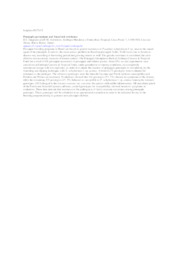Pineapple germplasm and Fusariosis resistance.
Pineapple germplasm and Fusariosis resistance.
Author(s): JUNGHANS, D. T.; MATOS, A. P. de
Summary: Pineapple breeding programs in Brazil are based on genetic resistance to Fusarium subglutinans f. sp. ananas the causal agent of the pineapple fusariosis; the most serious problem in Brazilian pineapple fields. Yield losses due to fusariosis disease vary according to harvesting period and growing season as well. The genetic resistance is considered the most effective and economic measure of disease control. The Pineapple Germplasm Bank at Embrapa Cassava & Tropical Fruits has a total of 616 pineapple accessions of pineapple and related species. Since 80's, several experiments were carried out at Embrapa Cassava & Tropical Fruits, under greenhouse or nursery conditions, in a completely randomized design with five replicates, in order to evaluate the reaction of pineapple genotypes to inoculation, by the wounding and dipping technique, with F. subglutinans f. sp. ananas. A total of 273 genotypes were evaluated for resistance to the pathogen. The reference genotypes were the Smooth Cayenne and Pérola cultivars (susceptible) and Perolera and Primavera (resistant). Evaluations showed that 144 genotypes (52, 7%) showed no symptoms of the disease, while the remaining 129 genotypes (47, 3%) behaved as susceptible to F. subglutinans f. sp. ananas. Among the resistant genotypes, 105 belonged to the Ananas comosus var. comosus, the species with edible infrutescence. All inoculated plants of the Pérola and Smooth Cayenne cultivars, control genotypes for susceptibility, showed fusariosis symptoms at evaluation. These data indicate that resistance to the pathogen is of fairly common occurrence among pineapple genotypes. These genotypes will be submitted to an agronomical evaluation in order to be indicated for use in the breeding program aiming to generate new pineapple hybrids.
Publication year: 2010
Types of publication: Abstract in annals or event proceedings
Unit: Embrapa Cassava & Fruits
Keywords: Abacaxi, Doença de Planta, Fusariose, Fusarium subglutinans, Pineapple
Observation
Some of Embrapa's publications are published as ePub files. To read them, use or download one of the following free software options to your computer or mobile device. Android: Google Play Books; IOS: iBooks; Windows and Linux: Calibre.
Access other publications
Access the Agricultural Research Database (BDPA) to consult Embrapa's full library collection and records.
Visit Embrapa Bookstore to purchase books and other publications sold by Embrapa.

